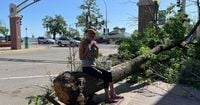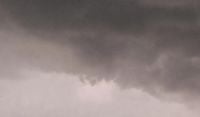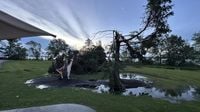Late Friday night into the early hours of Saturday, June 21, 2025, a devastating series of storms swept across North Dakota and northern Minnesota, leaving a trail of destruction, three confirmed fatalities, and widespread power outages. The violent weather event combined the fury of a derecho and multiple powerful tornadoes, most notably near the small town of Enderlin, North Dakota, where the deadliest tornado struck.
The storm system began with intense supercells forming over central North Dakota late Friday evening. These supercells generated several large, violent tornadoes that touched down in multiple counties including Stutsman, Barnes, Ransom, and Cass. Around 11:40 p.m., deputies from the Cass County Sheriff's Office were dispatched to a heavily damaged home near Enderlin after reports of a tornado strike. Upon arrival, storm chasers had already found two people deceased inside the home. Shortly thereafter, firefighters from the Enderlin Sheldon Fire Department discovered a third fatality at a separate location. Sheriff Jesse Jahner confirmed that two men and one woman lost their lives, emphasizing that the nighttime nature of the tornado likely contributed to the tragic outcome. "When you can't see the thing coming, and the next thing you know the winds are high, it doesn't give you a lot of probably, you know, potential for a response time," Jahner said during a Saturday morning news conference.
Enderlin, a rural town of about 900 residents located approximately 57 miles southwest of Fargo, suffered severe damage. Jon Anderson, chief of the Enderlin Sheldon Fire Department, reported that roughly 10 homes were destroyed in the area. Social media images showed homes reduced to their foundations and even a train pushed off its tracks and tipped on its side in a nearby field, underscoring the tornado's ferocity. Meteorologist Andy Hill described the Enderlin tornado as "one of the strongest tornadoes" he has covered, with radar data suggesting it could be the strongest tornado ever recorded in North Dakota, though the National Weather Service (NWS) has yet to officially verify its intensity.
Meanwhile, the derecho—a widespread, long-lasting windstorm—raced across North Dakota, northern Minnesota, and northern Wisconsin, producing sustained wind gusts between 70 and 110 mph. A private weather station near Luverne, North Dakota, recorded a peak gust of 111 mph around 12:45 a.m. Saturday, while the Bemidji Airport in Minnesota logged a 106 mph gust. These hurricane-force winds caused massive damage, uprooting thousands of trees and ripping roofs off homes.
Beltrami County in northern Minnesota bore the brunt of the storm's wrath east of the tornado zone. Emergency managers reported extensive structural damage, blocked roads, and numerous downed power lines. Christopher Muller, director of Beltrami County Emergency Management, urged residents to avoid unnecessary travel, stating, "There is extensive damage around the Bemidji area and much of southern Beltrami County. Please do not travel unless it is an emergency. Many roads are blocked and there are a ton of power lines down. Unfortunately, there is significant structure damage as well. We are responding to many gas leaks." Torrential rains compounded the destruction, triggering flash flooding in downtown Bemidji that stalled vehicles and rendered several streets impassable.
Despite the widespread damage, no injuries were reported in Beltrami County. However, thousands of residents were displaced, and over 80% of the county remained without power as of Saturday morning. The American Red Cross, Salvation Army, and local officials mobilized to provide temporary housing and aid, with resources available at the Sanford Convention Center. Federal Homeland Security personnel also arrived on the scene to assist with recovery efforts.
Power outages were widespread across the region, with Montana Dakota Utilities reporting over 6,000 outages and Capital Electric another 500 in North Dakota. According to FindEnergy.com, more than 57,000 customers in Minnesota and around 30,000 in North Dakota lost electricity at the peak of the storm. Beltrami County alone accounted for over 22,500 of the Minnesota outages.
National Weather Service forecasters described the event as one of the most significant and widespread severe weather outbreaks in recent memory. Timothy Lynch, a lead forecaster at the NWS office in Grand Forks, North Dakota, remarked, "It's not an everyday event to see multiple wind gusts of over 100 miles per hour. This has probably been one of the more widespread severe events, and definitely one of the most profound." The storm system's complex nature—combining supercells capable of spawning violent tornadoes with a fast-moving derecho producing widespread hurricane-force winds—made it particularly destructive.
In addition to tornadoes and high winds, the storm produced hail up to three inches in diameter in Jamestown, North Dakota, and parts of northwest Minnesota. Fargo experienced less severe damage, limited mostly to broken tree branches and some flooding in underpasses.
Authorities continue to assess the full extent of the damage as cleanup efforts begin. Roads remain blocked by fallen trees and debris, complicating recovery operations. Emergency managers caution residents to prepare for long-term power outages due to the significant infrastructure damage. Meanwhile, the threat of further severe weather looms, with forecasts indicating additional rounds of thunderstorms possible on Saturday afternoon and evening, and again on Sunday.
This devastating storm serves as a stark reminder of the power of nature and the importance of preparedness. As communities in North Dakota and Minnesota begin the slow process of recovery, support from local, state, and federal agencies will be crucial to help residents rebuild and heal from this unprecedented weather event.



